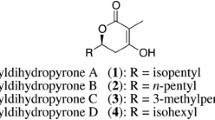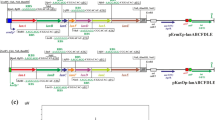Abstract
From cell-free extracts of Streptomyces RGU5.3, a tailoring activity of pimaricin, leading to the biosynthesis of its natural carboxamide derivative AB-400, was recently identified. The two polyene macrolides, pimaricin and AB-400, were produced in almost equal quantities and can be detected in the fermentation broth of the producer strain. This report concerns the isolation and partial characterization of the gene, polyene carboxamide synthase (pcsB), responsible for the bioconversion. The gene encoded an asparagine synthase-like protein, belonging to the type II glutamine amidotransferase family, and was named pcsB. The fermentation broth of a recombinant strain carrying the engineered pcsB gene under the control of the inducible tipA promoter within an integrative vector produces the carboxamide AB-400 as the main polyene macrolide.




Similar content being viewed by others
References
Anton N, Mendes MV, Martin JF et al (2004) Identification of PimR as a positive regulator of pimaricin biosynthesis in Streptomyces natalensis. J Bacteriol 186:2567–2575
Anton N, Santos-Aberturas J, Mendes MV et al (2007) PimM, a PAS domain positive regulator of pimaricin biosynthesis in Streptomyces natalensis. Microbiology 153:3174–3183
Aparicio JF, Colina AJ, Ceballos E et al (1999) The biosynthetic gene cluster for the 26-membered ring polyene macrolide pimaricin: a new polyketide synthase organization encoded by two subclusters separated by functionalization genes. J Biol Chem 274:10133–10139
Aparicio JF, Fouces R, Mendes MV et al (2000) A complex multienzyme system encoded by five polyketide synthase genes is involved in the biosynthesis of the 26-membered polyene macrolide pimaricin in Streptomyces natalensis. Chem Biol 7:895–905
Atlas RM (1993) Microbiological media. CRC, Boca Raton
Berges H, Checroun C, Guiral S et al (2001) A glutamine-amidotransferase-like protein modulates FixT anti-kinase activity in Sinorhizobium meliloti. BMC Microbiol 1:6
Bruzzese T, Rimaroli C, Bonabello A et al (1996) Amide derivatives of partricin A with potent antifungal activity. Eur J Med Chem 31:965–972
Caffrey P, Aparicio JF, Malpartida F et al (2008) Biosynthetic engineering of polyene macrolides towards generation of improved antifungal and antiparasitic agents. Curr Top Med Chem 8:639–653
Cañedo LM, Costa L, Criado LM et al (2000) AB-400, a new tetraene macrolide isolated from Streptomyces costae. J Antibiot (Tokyo) 53:623–626
Chapman SW, Sullivan DC, Cleary JD (2008) In search of the holy grail of antifungal therapy. Trans Am Clin Climatol Assoc 119:197–215
Chin-A-Woeng TFC, Thomas-Oates JE, Lugtenberg BJ et al (2001) Introduction of the phzH gene of Pseudomonas chlororaphis PCL1391 extends the range of biocontrol ability of phenazine-1-carboxylic acid-producing Pseudomonas spp. strains. Mol Plant Microbe Interact 14:1006–1015
Coukell AJ, Brogden RN (1998) Liposomal amphotericin B. Therapeutic use in the management of fungal infections and visceral leishmaniasis. Drugs 55:585–612
Cybulska B, Bolard J, Seksek O et al (1995) Identification of the structural elements of amphotericin B and other polyene macrolide antibiotics of the heptaene group influencing the ionic selectivity of the permeability pathways formed in the red cell membrane. Biochim Biophys Acta 1240:167–178
Ekins S, Mestres J, Testa B (2007) In silico pharmacology for drug discovery: applications to targets and beyond. Br J Pharmacol 152:21–37
El-Gendy MM, Shaaban M, Shaaban KA et al (2008) Essramycin: a first triazolopyrimidine antibiotic isolated from nature. J Antibiot (Tokyo) 61:149–157
Enriquez LL, Mendes MV, Anton N et al (2006) An efficient gene transfer system for the pimaricin producer Streptomyces natalensis. FEMS Microbiol Lett 257:312–318
Frischauf AM, Lehrach H, Poustka A et al (1992) Lambda replacement vectors carrying polylinker sequences. J Mol Biol 170:827–842
Ghorbel S, Kormanec J, Artus A et al (2006) Transcriptional studies and regulatory interactions between the phoR-phoP operon and the phoU, mtpA, and ppk genes of Streptomyces lividans TK24. J Bacteriol 188:677–686
Gonzalez-Diaz H, Prado-Prado F, Ubeira FM (2008) Predicting antimicrobial drugs and targets with the MARCH-INSIDE approach. Curr Top Med Chem 8:1676–1690
Hirasawa T, Wachi M, Nagai K (2000) A mutation in the Corynebacterium glutamicum ltsA gene causes susceptibility to lysozyme, temperature-sensitive growth, and L-glutamate production. J Bacteriol 182:2696–2701
Jarzebski A, Falkowski L, Borowski E (1982) Synthesis and structure–activity relationships of amides of amphotericin B. J Antibiot (Tokyo) 35:220–229
Kieser T, Bibb MJ, Buttner MJ et al (2000) Practical Streptomyces genetics. John Innes Foundation, Norwich
MacNeil DJ, Gewain KM, Ruby CL et al (1992) Analysis of Streptomyces avermitilis genes required for avermectin biosynthesis utilizing a novel integration vector. Gene 111:61–68
Malpartida F, Hopwood DA (1986) Physical and genetic characterisation of the gene cluster for the antibiotic actinorhodin in Streptomyces coelicolor A3(2). Mol Gen Genet 205:66–73
Maniatis T, Fritsch EF, Sambrook J (1982) Molecular cloning: a laboratory manual. Cold Spring Harbor Laboratory, Cold Spring Harbor
Mavrodi DV, Bonsall RF, Delaney SM et al (2001) Functional analysis of genes for biosynthesis of pyocyanin and phenazine-1-carboxamide from Pseudomonas aeruginosa PAO1. J Bacteriol 183:6454–6465
Mazerski J, Bolard J, Borowski E (1995) Effect of the modifications of ionizable groups of amphotericin B on its ability to form complexes with sterols in hydroalcoholic media. Biochim Biophys Acta 1236:170–176
Mendes MV, Recio E, Fouces R et al (2001) Engineered biosynthesis of novel polyenes: a pimaricin derivative produced by targeted gene disruption in Streptomyces natalensis. Chem Biol 8:635–644
Mendes MV, Anton N, Martin JF et al (2005) Characterization of the polyene macrolide P450 epoxidase from Streptomyces natalensis that converts de-epoxypimaricin into pimaricin. Biochem J 386:57–62
Mendes MV, Recio E, Anton N et al (2007a) Cholesterol oxidases act as signaling proteins for the biosynthesis of the polyene macrolide pimaricin. Chem Biol 14:279–290
Mendes MV, Tunca S, Anton N et al (2007b) The two-component phoR-phoP system of Streptomyces natalensis: inactivation or deletion of phoP reduces the negative phosphate regulation of pimaricin biosynthesis. Metab Eng 9:217–227
Mitani Y, Meng X, Kamagata Y et al (2005) Characterization of LtsA from Rhodococcus erythropolis, an enzyme with glutamine amidotransferase activity. J Bacteriol 187:2582–2591
Murakami T, Holt TG, Thompson CJ (1989) Thiostrepton-induced gene expression in Streptomyces lividans. J Bacteriol 171:1459–1466
Nosanchuk JD (2006) Current status and future of antifungal therapy for systemic mycoses. Recent Pat Antiinfect Drug Discov 1:75–84
Odds FC, Brown AJ, Gow NA (2003) Antifungal agents: mechanisms of action. Trends Microbiol 11:272–279
Paquet V, Carreira EM (2006) Significant improvement of antifungal activity of polyene macrolides by bisalkylation of the mycosamine. Org Lett 8:1807–1809
Paquet V, Volmer AA, Carreira EM (2008) Synthesis and in vitro biological properties of novel cationic derivatives of amphotericin B. Chemistry 14:2465–2481
Pérez-Zúñiga FJ, Seco EM, Cuesta T et al (2004) CE-108, a new macrolide tetraene antibiotic. J Antibiot (Tokyo) 57:197–204
Power P, Dunne T, Murphy B et al (2008) Engineered synthesis of 7-oxo- and 15-deoxy-15-oxo-amphotericins: insights into structure-activity relationships in polyene antibiotics. Chem Biol 15:78–86
Preobrazhenskaya MN, Olsufyeva EN, Solovieva SE et al (2008) Chemical modification and biological evaluation of new semisynthetic derivatives of 28, 29-didehydronystatin A(1) (S44HP), a genetically engineered antifungal polyene macrolide antibiotic. J Med Chem 52:189–196
Ramos-Vega AL, Davila-Martinez Y, Sohlenkamp C et al (2009) SMb20651 is another acyl carrier protein from Sinorhizobium meliloti. Microbiology 155:257–267
Ren H, Liu J (2006) AsnB is involved in natural resistance of Mycobacterium smegmatis to multiple drugs. Antimicrob Agents Chemother 50:250–255
Resat H, Sungur FA, Baginski M et al (2000) Conformational properties of amphotericin B amide derivatives—impact on selective toxicity. J Comput Aided Mol Des 14:689–703
Rice P, Longden I, leasby A (2000) EMBOSS: the European Molecular Biology Open Software Suite. Trends Genet 16:276–277
Risovic V, Boyd M, Choo E et al (2003) Effects of lipid-based oral formulations on plasma and tissue amphotericin B concentrations and renal toxicity in male rats. Antimicrob Agents Chemother 47:3339–3342
Sachs-Barrable K, Lee SD, Wasan EK et al (2008) Enhancing drug absorption using lipids: a case study presenting the development and pharmacological evaluation of a novel lipid-based oral amphotericin B formulation for the treatment of systemic fungal infections. Adv Drug Deliv Rev 60:692–701
Saint-Julien L, Joly V, Seman M et al (1992) Activity of MS-8209, a nonester amphotericin B derivative, in treatment of experimental systemic mycoses. Antimicrob Agents Chemother 36:2722–2728
Sarachu M, Colet M (2005) wEMBOSS: a web interface for EMBOSS. Bioinformatics 21:540–541
Seco EM, Pérez-Zuñiga FJ, Rolón MS et al (2004) Starter unit choice determines the production of two tetraene macrolides, rimocidin and CE-108, in Streptomyces diastaticus var. 108. Chem Biol 11:357–366
Seco EM, Cuesta T, Fotso S et al (2005a) Two polyene amides produced by genetically modified Streptomyces diastaticus var. 108. Chem Biol 12:535–543
Seco EM, Fotso S, Laatsch H et al (2005b) A tailoring activity is responsible for generating polyene amide derivatives in Streptomyces diastaticus var. 108. Chem Biol 12:1093–1101
Sola-Landa A, Moura RS, Martin JF (2003) The two-component PhoR-PhoP system controls both primary metabolism and secondary metabolite biosynthesis in Streptomyces lividans. Proc Natl Acad Sci USA 100:6133–6138
te Welscher YM, ten Napel HH, Balague MM et al (2008) Natamycin blocks fungal growth by binding specifically to ergosterol without permeabilizing the membrane. J Biol Chem 283:6393–6401
Volff JN, Eichenseer C, Viell P et al (1996) Nucleotide sequence and role in DNA amplification of the direct repeats composing the amplifiable element AUD1 of Streptomyces lividans 66. Mol Microbiol 21:1037–1047
Welscher YM, ten Napel HH, Balague MM et al (2008) Natamycin blocks fungal growth by binding specifically to ergosterol without permeabilizing the membrane. J Biol Chem 283:6393–6401
Wright F, Bibb MJ (1992) Codon usage in the G+C-rich Streptomyces genome. Gene 113:55–65
Yanisch-Perron C, Vieira J, Messing J (1985) Improved M13 phage cloning vectors and host strains: nucleotide sequences of the M13mp18 and pUC19 vectors. Gene 33:103–119
Yardley V, Croft SL (1997) Activity of liposomal amphotericin B against experimental cutaneous leishmaniasis. Antimicrob Agents Chemother 41:752–756
Yoshida K, Fujita Y, Ehrlich SD (1999) Three asparagine synthetase genes of Bacillus subtilis. J Bacteriol 181:6081–6091
Zalkin H (1998) Enzymes utilizing glutamine as an amide donor. Adv Enzymol Relat Areas Mol Biol 72:87–144
Acknowledgments
This work was supported by Grants from Spanish Ministerio de Ciencia e Innovación BIO2005-02785, BIO2008-03683, and CIT-010000-2008-4. We do not have any conflict of interest which may affect either the results or our interpretation. We thank Sir Prof. David A. Hopwood for critical reading the manuscript. We thank C. Nieto for her excellent technical help.
Author information
Authors and Affiliations
Corresponding author
Rights and permissions
About this article
Cite this article
Miranzo, D., Seco, E.M., Cuesta, T. et al. Isolation and characterization of pcsB, the gene for a polyene carboxamide synthase that tailors pimaricin into AB-400. Appl Microbiol Biotechnol 85, 1809–1819 (2010). https://doi.org/10.1007/s00253-009-2195-1
Received:
Revised:
Accepted:
Published:
Issue Date:
DOI: https://doi.org/10.1007/s00253-009-2195-1




